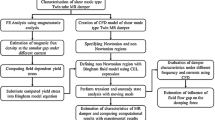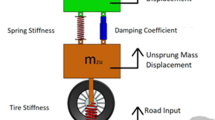Abstract
The smart behavior of magneto-rheological (MR) fluid is used in the present work in designing, experimentally characterizing and analyzing a MR damper for automotive application using the twin-tube damper concept. A commercially available passive damper of a passenger van was tested to find the characteristic damping requirement of the vehicle. With this as reference, a twin-tube MR damper working in valve mode was designed and fabricated. The magnetic flux density induced in the fluid flow gap is maximized using Taguchi analysis and finite element method magnetics (FEMM) software. The FEMM results are validated by verifying with results obtained analytically using electromagnetic circuit theory. The MR damper filled with commercially available MR fluid was experimentally tested in damper testing machine. The results demonstrate that the force developed by the MR damper is indeed increasing with the value of the current supplied. At various frequencies of input oscillation, the energy dissipated by the MR damper in a single cycle increases significantly with current supplied. The novelty of this work is that a twin-tube MR damper working in valve mode was designed as a replacement for the passive damper used in a passenger van. The MR damper thus developed is capable of producing practical levels of damping force at actual operating frequencies and amplitudes of the passive damper in the passenger van. For further analysis, the behavior of the MR damper is modeled by using the Bouc–Wen model for hysteretic systems. A proportional–integral–derivative controller is used to track the desired damping force in time domain to demonstrate the application of the MR damper in a semi-active suspension system.






















Similar content being viewed by others
References
Ahmadian M (2017) Magneto-rheological suspensions for improving ground vehicle’s ride comfort, stability and handling. Veh Syst Dyn 55(10):1618–1642. https://doi.org/10.1080/00423114.2017.1323106
Nguyen QH, Han YM, Choi SB, Wereley NM (2007) Geometry optimization of MR valves constrained in a specific volume using the finite element method. Smart Mater Struct 16(6):2242–2252. https://doi.org/10.1088/0964-1726/16/6/027
Gołdasz J (2013) Electro-mechanical analysis of a magnetorheological damper with electrical steel laminations. Przegląd Elektrotechniczny 89(2a):8–12
Kubík M, Macháček O, Strecker Z, Roupec J, Mazůrek I (2017) Design and testing of magnetorheological valve with fast force response time and great dynamic force range. Smart Mater Struct 26(4):047002. https://doi.org/10.1088/1361-665X/aa6066
Parlak Z, Engin T (2013) Optimal magnetorheological damper configuration using the Taguchi experimental design method. J Mech Des 135(8):081008. https://doi.org/10.1115/1.4024719
Hu G, Liu F, Xie Z, Xu M (2016) Design, analysis, and experimental evaluation of a double coil magnetorheological fluid damper. Shock Vibr 2016:4184726. https://doi.org/10.1155/2016/4184726
Rahman M, Ong ZC, Julai S, Ferdaus MM, Ahamed R (2017) A review of advances in magnetorheological dampers: their design optimization and applications. J Zhejiang Univ Sci A 18(12):991–1010. https://doi.org/10.1631/jzus.A1600721
Parlak Z, Engin T, Çallı İ (2012) Optimal design of MR damper via finite element analyses of fluid dynamic and magnetic field. Mechatronics 22(6):890–903. https://doi.org/10.1016/j.mechatronics.2012.05.007
Yang G, Spencer BF, Carlson JD, Sain MK (2002) Large-scale MR fluid dampers: modeling and dynamic performance considerations. Eng Struct 24(3):309–323
Nguyen QH, Choi SB (2008) Optimal design of a vehicle magnetorheological damper considering the damping force and dynamic range. Smart Mater Struct 18(1):015013. https://doi.org/10.1088/0964-1726/18/1/015013
Yazid IM, Mazlan SA, Zamzuri H, Mughni MJ, Chuprat S (2013) Parameters consideration in designing a magnetorheological damper. Key Eng Mater 543:487–490. https://doi.org/10.4028/www.scientific.net/KEM.543.487
Spencer BFJ, Dyke SJ, Sain MK, Carlson JD (1997) Phenomenological model for magnetorheological dampers. J Eng Mech 123(3):230–238. https://doi.org/10.1061/(ASCE)0733-9399(1997)123:3(230)
Abd Fatah AY, Mazlan SA, Koga T, Zamzuri H, Zeinali M, Imaduddin F (2015) A review of design and modeling of magnetorheological valve. Int J Mod Phys B 29(04):1530004. https://doi.org/10.1142/S0217979215300042
Domínguez-González A, Stiharu I, Sedaghati R (2014) Practical hysteresis model for magnetorheological dampers. J Intell Mater Syst Struct 25(8):967–979. https://doi.org/10.1177/1045389X13502867
Kwok NM, Ha QP, Nguyen MT, Li J, Samali B (2007) Bouc–Wen model parameter identification for a MR fluid damper using computationally efficient GA. ISA Trans 46(2):167–179. https://doi.org/10.1016/j.isatra.2006.08.005
Guan XC, Guo PF, Ou JP (2011) Modeling and analyzing of hysteresis behavior of magneto rheological dampers. Procedia Eng 14:2756–2764. https://doi.org/10.1016/j.proeng.2011.07.347
Gurubasavaraju TM, Kumar H, Mahalingam A (2018) An approach for characterizing twin-tube shear-mode magnetorheological damper through coupled FE and CFD analysis. J Braz Soc Mech Sci Eng 40(3):139. https://doi.org/10.1007/s40430-018-1066-z
Hemantha KH, Gangadharan KKV (2016) Vertical dynamic analysis of a quarter car suspension system with MR damper. J Braz Soc Mech Sci Eng 39(1):41–51. https://doi.org/10.1007/s40430-015-0481-7
Gurubasavaraju TM, Kumar H, Arun M (2017) Optimisation of monotube magnetorheological damper under shear mode. J Braz Soc Mech Sci Eng 39(6):2225–2240. https://doi.org/10.1007/s40430-017-0709-9
Krishna H, Kumar H, Gangadharan K (2017) Optimization of magneto-rheological damper for maximizing magnetic flux density in the fluid flow gap through FEA and GA approaches. J Inst Eng (India) Ser C 98(4):533–539. https://doi.org/10.1007/s40032-016-0251-z
Gurubasavaraju TM, Kumar H, Arun M (2017) Evaluation of optimal parameters of MR fluids for damper application using particle swarm and response surface optimisation. J Braz Soc Mech Sci Eng 39(9):3683–3694. https://doi.org/10.1007/s40430-017-0875-9
Shivaram AC, Gangadharan KV (2007) Statistical modeling of a magneto-rheological fluid damper using the design of experiments approach. Smart Mater Struct 16(4):1310–1314. https://doi.org/10.1088/0964-1726/16/4/044
Hemanth K, Ganesha A, Hemantha K, Gangadharan KV (2014) Analysis of MR damper based on finite element approach. Appl Mech Mater 592:2006–2010. https://doi.org/10.4028/www.scientific.net/AMM.592-594.2006
Tharehalli Mata G, Kumar H, Mahalingam A (2018) Performance analysis of a semi-active suspension system using coupled CFD–FEA based non-parametric modeling of low capacity shear mode monotube MR damper. Proc Inst Mech Eng Part D J Automob Eng. https://doi.org/10.1177/0954407018765899
MRF-132DG Magneto-Rheological Fluid data sheet. http://www.lordmrstore.com/lord-mr-products/mrf-132dg-magneto-rheological-fluid. Accessed 13 Apr 2019
Poynor JC (2001) Innovative designs for magneto-rheological dampers. Doctoral dissertation, Virginia Tech
EN1A Steel. https://kvsteel.co.uk/steel/EN1A.html. Accessed 12 Apr 2019
Baltzis KB (2008) The FEMM package: a simple, fast, and accurate open source electromagnetic tool in science and engineering. J Eng Sci Technol Rev 1(1):83–89
Montgomery D (1997) Design and analysis of experiments, 4th edn. Wiley, New York, pp 622–629
Nguyen QH, Choi SB, Wereley NM (2008) Optimal design of magnetorheological valves via a finite element method considering control energy and a time constant. Smart Mater Struct 17(2):025024. https://doi.org/10.1088/0964-1726/17/2/025024
Parlak Z, Engin T, Ari V, Sahin I, Calli I (2010) Geometrical optimisation of vehicle shock dampers with magnetorheological fluid. Int J Veh Des 54(4):371–392. https://doi.org/10.1504/IJVD.2010.036842
Wang DH, Liao WH (2011) Magnetorheological fluid dampers: a review of parametric modelling. Smart Mater Struct 20(2):023001. https://doi.org/10.1088/0964-1726/20/2/023001
Peng Y, Yang J, Li J (2018) Parameter identification of modified Bouc–Wen model and analysis of size effect of magnetorheological dampers. J Intell Mater Syst Struct 29(7):1464–1480. https://doi.org/10.1177/1045389X17740963
Acknowledgements
This research work was financially supported by Ministry of Human Resource Development (MHRD) and Ministry of Road Transport and Highways, Government of India, through Impacting Research Innovation and Technology (IMPRINT) Project No. IMPRINT/2016/7330 titled ‘Development of cost-effective magneto-rheological (MR) fluid damper in two-wheeler and four-wheeler automobile to improve ride comfort and stability.’ Also, the authors acknowledge the technical support in designing and manufacturing the prototype MR damper provided by engineers Mr. G. Amarnath and Mr. M. G. K. Saravanan who are employees of Rambal Ltd., Thiruporur, Chennai-603 110, India. The authors wish to express their gratefulness to Rambal Ltd. for providing facilities to conduct the damper testing experiments.
Author information
Authors and Affiliations
Corresponding author
Ethics declarations
Conflict of interest
The authors declare that they have no conflict of interest in the publication of this article.
Additional information
Technical Editor: Pedro Manuel Calas Lopes Pacheco, D.Sc.
Publisher's Note
Springer Nature remains neutral with regard to jurisdictional claims in published maps and institutional affiliations.
Rights and permissions
About this article
Cite this article
Desai, R.M., Jamadar, M.E.H., Kumar, H. et al. Design and experimental characterization of a twin-tube MR damper for a passenger van. J Braz. Soc. Mech. Sci. Eng. 41, 332 (2019). https://doi.org/10.1007/s40430-019-1833-5
Received:
Accepted:
Published:
DOI: https://doi.org/10.1007/s40430-019-1833-5




